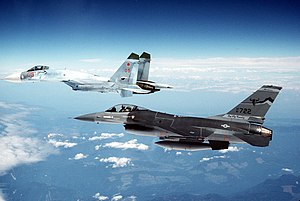| Fourth-generation fighter | |
|---|---|
 A Sukhoi Su-27 (background) and General Dynamics F-16 Fighting Falcon (foreground), fourth-generation fighters used by the Soviet Air Force and United States Air Force respectively | |
| General information | |
| Type | Fighter aircraft |
| National origin | Multi-national |
| Status | In service |
| History | |
| Introduction date | 1980s |
| First flight | 1970s |
| Developed from | Third-generation fighter |
| Developed into | Fifth-generation fighter |
The fourth-generation fighter is a class of jet fighters in service from around 1980 to the present, and represents design concepts of the 1970s. Fourth-generation designs are heavily influenced by lessons learned from the previous generation of combat aircraft. Third-generation fighters were often designed primarily as interceptors, being built around speed and air-to-air missiles. While exceptionally fast in a straight line, many third-generation fighters severely lacked in maneuverability, as doctrine held that traditional dogfighting would be impossible at supersonic speeds. In practice, air-to-air missiles of the time, despite being responsible for the vast majority of air-to-air victories, were relatively unreliable, and combat would quickly become subsonic and close-range. This would leave third-generation fighters vulnerable and ill-equipped, renewing an interest in manoeuvrability for the fourth generation of fighters. Meanwhile, the growing costs of military aircraft in general and the demonstrated success of aircraft such as the McDonnell Douglas F-4 Phantom II gave rise to the popularity of multirole combat aircraft in parallel with the advances marking the so-called fourth generation.
During this period, maneuverability was enhanced by relaxed static stability, made possible by introduction of the fly-by-wire (FBW) flight-control system, which in turn was possible due to advances in digital computers and system-integration techniques. Replacement of analog avionics, required to enable FBW operations, became a fundamental requirement as legacy analog computer systems began to be replaced by digital flight-control systems in the latter half of the 1980s.[1] The further advance of microcomputers in the 1980s and 1990s permitted rapid upgrades to the avionics over the lifetimes of these fighters, incorporating system upgrades such as active electronically scanned array (AESA), digital avionics buses, and infra-red search and track.
Due to the dramatic enhancement of capabilities in these upgraded fighters and in new designs of the 1990s that reflected these new capabilities, they have come to be known as 4.5 generation. This is intended to reflect a class of fighters that are evolutionary upgrades of the fourth generation incorporating integrated avionics suites, advanced weapons efforts to make the (mostly) conventionally designed aircraft nonetheless less easily detectable and trackable as a response to advancing missile and radar technology (see stealth technology).[2][3] Inherent airframe design features exist and include masking of turbine blades and application of advanced sometimes radar-absorbent materials, but not the distinctive low-observable configurations of the latest aircraft, referred to as fifth-generation fighters or aircraft such as the Lockheed Martin F-22 Raptor.
The United States defines 4.5-generation fighter aircraft as fourth-generation jet fighters that have been upgraded with AESA radar, high-capacity data-link, enhanced avionics, and "the ability to deploy current and reasonably foreseeable advanced armaments".[4][5] Contemporary examples of 4.5-generation fighters are the Sukhoi Su-30SM/Su-34/Su-35,[6] Shenyang J-15B/J-16,[7] Chengdu J-10C, Mikoyan MiG-35, Eurofighter Typhoon, Dassault Rafale, Saab JAS 39E/F Gripen, Boeing F/A-18E/F Super Hornet, Lockheed Martin F-16E/F/V Block 70/72, McDonnell Douglas F-15E/EX Strike Eagle/Eagle II, HAL Tejas MK1A,[8] CAC/PAC JF-17 Block 3, and Mitsubishi F-2.[9]
- ^ Hoh, Roger H. and David G. Mitchell. "Flying Qualities of Relaxed Static Stability Aircraft - Volume I: Flying Qualities Airworthiness Assessment and Flight Testing of Augmented Aircraft". Federal Aviation Administration (DOT/FAA/CT-82/130-I), September 1983. pp. 11ff.
- ^ Fulghum, David A. and Douglas Barrie "F-22 Tops Japan's Military Wish List". Aviation Week and Space Technology, 22 April 2007. Retrieved 3 October 2010. Archived 27 September 2011 at the Wayback Machine.
- ^ "The Gray Threat" (Archived 2007-08-19 at the Wayback Machine). Air Force Magazine.
- ^ "CRS RL33543: Tactical Aircraft Modernization" (Archived 2009-08-30 at the Wayback Machine). Issues for Congress 9 July 2009. Retrieved 3 October 2010.
- ^ "National Defense Authorization Act for Fiscal Year 2010 (Enrolled as Agreed to or Passed by Both House and Senate)" (Archived 2010-11-04 at the Wayback Machine). thomas.loc.gov. Retrieved 3 October 2010.
- ^ Gady, Franz-Stefan. "Russia to Upgrade Su-30SM Fighter Jets in 2018". thediplomat.com.
- ^ "Russian and Chinese Combat Air Trends" (PDF). p. P6. Archived from the original (PDF) on 2021-01-23. Retrieved 2021-05-07.
- ^ Karnad, Bharat (January 21, 2019). "A Liability Called Rafale". Point of View. India Today. New Delhi.
- ^ Gady, Franz-Stefan. "Is Japan Facing a Shortage of Fighter Aircraft?". thediplomat.com.